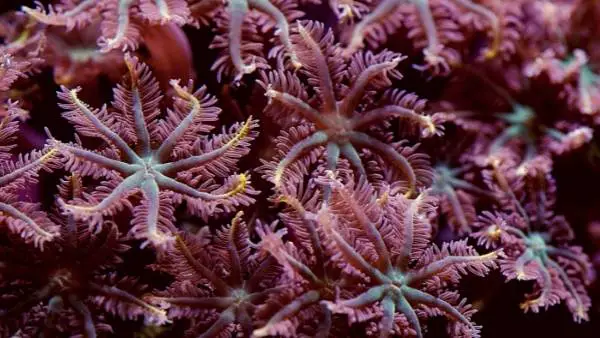If you are in possession, or considering acquiring a reef tank and are looking for fast-growing yet beautifully colored coral, then look no further than the Blue clove polyps!
Purple or Blue clove polyp corals are incredibly hardy, requiring no special water conditions or a specific nutritional diet, they are also very bright and look fantastic residing in a populated reef tank.
Blue Clove Polyp General Information and Requirements
In this care guide, we will be running through everything you need to know about owning a Clove polyp coral.

These coral are incredibly fast-growing, with the ability to easily take over a tank in a short period of time, which is why it is important to follow steps to ensure that your tank does not suddenly become a Blue clove polyp breeding ground.
Blue Clove Polyps Appearance and Behavior
The blue clove polyp coral is well-known by hobbyists as being called blue Anthelia coral and it closely resembles xenia corals. Additionally, they have a mat finish very similar to the Green star polyp coral and their coloration is blue and purple. They display incredibly small stalks with soft feathered polyps distributed around them.
Despite the blue cloves being such an appealing coral due to their mesmerizing appearance, hardiness, and being such low maintenance, many hobbyists choose other beginner-friendly corals.
This is because they grow at such a rapid rate that, before you know it, you have an infestation of blue clove polyps covering the majority of your tank, which is not going to be manageable or practical.
Many hobbyists with bigger setup, however, enjoy having colonies of them as it suits their massive tanks and adds a new dynamic to a reef community. However, if you own a small personal little aquarium, you should be careful when introducing these corals and make sure you keep an eye on the population too.
How to Feed Blue Clove Polyp Corals
Typically, these corals will grow and thrive in most conditions, not requiring certain water quality and lighting to survive and grow. They are photosynthetic and absorb most of their nutrition from zooxanthellae.
You do not need to feed them but if you feel it necessary, you can spot feed the blue clove coral. They usually pull food from the water column and also you can provide phytoplankton for them to feed off.
Water Flow and Lighting Requirements for Blue Clove Coral
How much water flow do they need? Well, blue clove polyps will need a moderate to high water flow to perform at their best. If your tank has low water flow then you are likely to see detritus build-up on the coral as it is usually removed by strong water flow.

These beautiful corals are generally not picky either when it comes to the lighting of your tank. They adapt quickly to different tank lighting, however, it is not recommended to have extremely bright lighting - low/medium is perfect. Anywhere between 50 and 150 par is perfect for these corals to thrive in.
What are the Perfect Water Parameters?
Due to these corals being very hardy, they will survive and thrive in water as long as the parameters are within normal limits. Basically, with the blue clove coral, you do not need perfect water conditions. Here are the perfect water parameters:
- Salinity: 1.025
- Temperature: 78-79F
- Calcium: 400-450 ppm
- Alkalinity: 8-11 dkh
- Magnesium: 1200-1350 ppm
- Phosphates: Close to 0
Do they Spread Quickly and how do you Frag?
At this point, it is no secret that these corals grow at a pretty rapid rate, so, it is advised to have them reside in an open space within your tank. They will typically grow on other rocks, equipment, glass, and sand beds.
Each month, you will notice them growing in size and numbers, with a small frag of Blue clove corals becoming a large colony in less than a year for some people, but it is usually around 12 months - still quick!
They are pretty difficult corals to frag as they cover rocks and you cannot cut anything other than the rock itself, which is pretty hard to do! By placing frag plugs or even discs next to an existing colony you will almost completely ensure that they will quickly grow onto them. Also, by breaking rock into small pieces with the coral attached you can create multiple frags.
Final Thoughts
This blue clove polyp coral is truly special, mostly because of how easy it is to look after, whilst still maintaining the aesthetic beauty of most other beginner corals that are available on the market today.
Something to be careful of is overpopulation, especially if you do not have a particularly big tank to keep them in. Despite all of that, they are a fantastic option for any hobbyist at any level.
